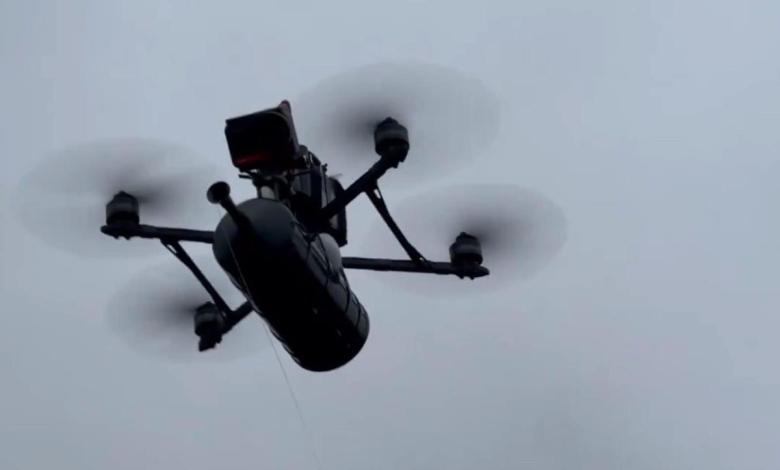Russia’s retro solution creates ‘unjammable’ drone

As the drone roars into the sky, we can see something unusual trailing behind it: a fiber optic cable that’s nearly invisible to the naked eye.
The other end of the cable connects to the pilot, who uses remote controls to guide the first-person machine toward its target: a Ukrainian armored vehicle parked on the side of the road.
This fiber-optic drone is the latest example of a low-tech solution being used to counter high-tech electronic warfare on the battlefield.
Hundreds of miles of Ukraine’s front lines are covered in an invisible but nearly impenetrable barrier of electronic pulses that knock drones out of the sky.
X/@GrandpaRoy2
Last year, French Army Chief of Staff General Pierre Schier said at an event in Paris that 75% of Russian and Ukrainian drones had been destroyed due to interference in Ukraine.
That’s why drone makers on both sides have reverted to a fairly basic strategy, reminiscent of a toy phone made from two cans tied together with a string.
Manufacturers have begun attaching spools of fiber optic cable to the landing gear of so-called “unjammable” drones so that soldiers on the ground can maintain decisive drone strike capabilities on the battlefield.
Kiev had hoped to achieve this feat by using artificial intelligence that could take over from human pilots to attack targets.
But with time running out on both sides of Russia’s invasion of Ukraine, they must take simpler steps to keep their drones flying and effective.
“Russia developed fiber-optic drones to solve the problem of effective electronic warfare,” said Justin Crump, CEO of strategic intelligence firm Sibylline.
“People think of drones pulling down a big spool of wire at the end of the tether, but the cable is so light that the drone can carry it and put it on the back, which means it won’t get snagged or stuck or provide resistance. .
The presence of physical cables between the drone and its pilot means that electronic warfare (EW) jammers cannot disrupt the common radio frequencies used to guide the drone.
Ukrainian drone pilot Ihor Yu said: “Although this technology is not new, it is very effective in modern warfare, especially against enemy active electronic countermeasures.”
“Despite some operational challenges, these drones are critical to the successful completion of specialized missions.”
Many of the fiber-optic drones looked a lot like other drones on display — quadcopters with explosives between the propellers.
The only difference is the cylindrical reel mechanism located under the drone’s belly to carry and disperse fiber optic cables.
The Washington-based Institute for the Study of War (ISW) reported on Wednesday that “Russian forces are increasingly using drones connected to fiber optic cables in Ukraine.”
This comes after a Russian report complained that Ukrainian electronic warfare “pinned their drones to the ground” as Kiev soldiers unexpectedly tried to penetrate deep into Russia’s Kursk region on Sunday.
“Our drones can’t do anything about it,” the Kremlin-friendly journalist wrote of the Ukrainian armored advance.
Russian sources said the first fiber-optic drones were integrated into Russian forces for combat operations on Wednesday, ISW reported.
Image source: X/@JKleinschmidtIR
However, they have been tested on the battlefield for longer.
Analysts say Russia may have the upper hand in producing and using these electronic warfare drones on the front lines.
But Ukrainian producers are fighting back and have begun building and testing their own models to overcome Moscow’s advantages in electronic warfare, including jamming and hacking techniques.
A dozen fiber-optic drones were shown for the first time in a recent demonstration organized by the Kyiv Defense Ministry.
Yevhenii Tkachenko, head of drones at Ukraine’s Defense Innovation Unit, said: “Russia continues to increase its capabilities in controlling drone technology using fiber optics, so it is crucial to offset its advantages in this area. important.
“Domestic manufacturers are demonstrating their readiness to quickly adapt to modern wartime challenges and implement cutting-edge developments.”
But it’s not as simple as gluing two empty cans of baked beans together.
While in action, the cables on the drones are at risk of getting stuck on their way to the target – @NOELreports
Cabling proved to be a challenge for producers.
While it’s considered sturdy, it can easily get stuck on the drone’s propellers.
The second issue is scope. The longer the cable, the heavier the drone, so the blast payload must be mitigated to compensate.
A Ukrainian manufacturer, 3DTech, told Forbes that the spooling device weighs about 300 grams and the three miles of cable weighs another 1.25 kilograms, meaning the overall size of the bomb had to be reduced by nearly three kilograms.
Drone operators must also learn a whole new set of skills from the knowledge they have accumulated over the course of the war.
Suspending cables isn’t a perfect science, so many outside factors, including pilot skill and whether the drone is traveling through heavily forested areas, can affect its likelihood of getting stuck. According to Forbes, during a test flight, a Ukrainian pilot hit a cyclist who crossed paths with the drone and cables.
The cables unravel to avoid tension when the drone moves, but the fiber optic lines can easily break if they become tangled in an obstacle between the pilot and the final target.
“Due to its inherent flaws, this control system is relatively rare globally, but it is likely to receive increasing attention in terms of exploitation and how to counter the persistent threat it poses,” Crump said.
Ukrainian soldiers defending these fiber-optic drones say they are vulnerable to small arms fire because they are not as maneuverable as wireless drones.
One Russian military blogger admitted that the Russian military will soon have to defend against similar Ukrainian-made weapons.
Broaden your horizons with award-winning British journalism. Try The Telegraph free for 1 month and get unlimited access to our award-winning website, exclusive apps, money-saving offers and more.


